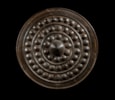Yetholm Sheild
This Yetholm-type bronze shield has a large central raised boss with three bands of alternating close-set domes and ridged bands. The outer edge of the shield has been folded back and hammered down to form a strong rim. It is thought these shields indicated a high social status, and were used to validate the idea of ‘warrior’ men. The surface was covered in a layer of metal with a different alloy, giving it an almost golden appearance, and it would have looked incredibly impressive when newly created and polished to a high shine. The Bronze Age is the name given to the period of time between the Stone and Iron Ages. In Britain it spanned from ca. 2500 until c. 800 BC, although the Bronze Age itself had already been in action in mainland Europe, thought to have started on the island of Crete. Bronze Age advances included agriculture, irrigation and the potter’s wheel; however, it is marked above all by the heavy use of bronze to fashion tools, decorative elements and weaponry. Many of the bronze items found within Great Britain were imported by the Belgae, Celts and Gauls. This includes the pieces themselves carried by travellers and also techniques and styles which were introduced to the British metal smiths. During the early Bronze Age, some people were buried in rich graves within round barrows, accompanied by exotic imported goods and weapons. These burials have been found throughout West Suffolk, where this shield was discovered. Often these burials were grouped in barrow cemeteries, such as Flowerdown Barrows, Hampshire, and Winterbourne Poor Lot Barrows, Dorset. These rich, individual burials signify a shift from the great Neolithic communal monuments like Stonehenge. The Yetholm-type shield was made in a style which prevailed in Britain and Ireland between 1300 and 800 BC. The name Yetholm is taken from a peat bog in the south of Scotland where three examples were first discovered, only a total of twenty-nine shields of this type having ever been discovered; of these, seven or eight are only known from written sources and are not in known collections. They generally consist of a central boss with bands of concentric repoussé domes and ridges, but vary significantly in size. This example was discovered by detectorists in Lakenheath, UK, only 45 miles away from the world-renowned Sutton Hoo ship burial.This Yetholm-type bronze shield has a large central raised boss with three bands of alternating close-set domes and ridged bands. The outer edge of the shield has been folded back and hammered down to form a strong rim. It is thought these shields indicated a high social status, and were used to validate the idea of ‘warrior’ men. The surface was covered in a layer of metal with a different alloy, giving it an almost golden appearance, and it would have looked incredibly impressive when newly created and polished to a high shine. The Bronze Age is the name given to the period of time between the Stone and Iron Ages. In Britain it spanned from ca. 2500 until c. 800 BC, although the Bronze Age itself had already been in action in mainland Europe, thought to have started on the island of Crete. Bronze Age advances included agriculture, irrigation and the potter’s wheel; however, it is marked above all by the heavy use of bronze to fashion tools, decorative elements and weaponry. Many of the bronze items found within Great Britain were imported by the Belgae, Celts and Gauls. This includes the pieces themselves carried by travellers and also techniques and styles which were introduced to the British metal smiths. During the early Bronze Age, some people were buried in rich graves within round barrows, accompanied by exotic imported goods and weapons. These burials have been found throughout West Suffolk, where this shield was discovered. Often these burials were grouped in barrow cemeteries, such as Flowerdown Barrows, Hampshire, and Winterbourne Poor Lot Barrows, Dorset. These rich, individual burials signify a shift from the great Neolithic communal monuments like Stonehenge. The Yetholm-type shield was made in a style which prevailed in Britain and Ireland between 1300 and 800 BC. The name Yetholm is taken from a peat bog in the south of Scotland where three examples were first discovered, only a total of twenty-nine shields of this type having ever been discovered; of these, seven or eight are only known from written sources and are not in known collections. They generally consist of a central boss with bands of concentric repoussé domes and ridges, but vary significantly in size. This example was discovered by detectorists in Lakenheath, UK, only 45 miles away from the world-renowned Sutton Hoo ship burial.
Discovered in Lakenheath, England, by Gintanus Krivickas in October 2015
Portable Antiquities Scheme unique ID: SF-E0D9C8
ALR: S00153673, with IADAA certificate, this item has been checked against the Interpol database










 Enquire
Enquire




